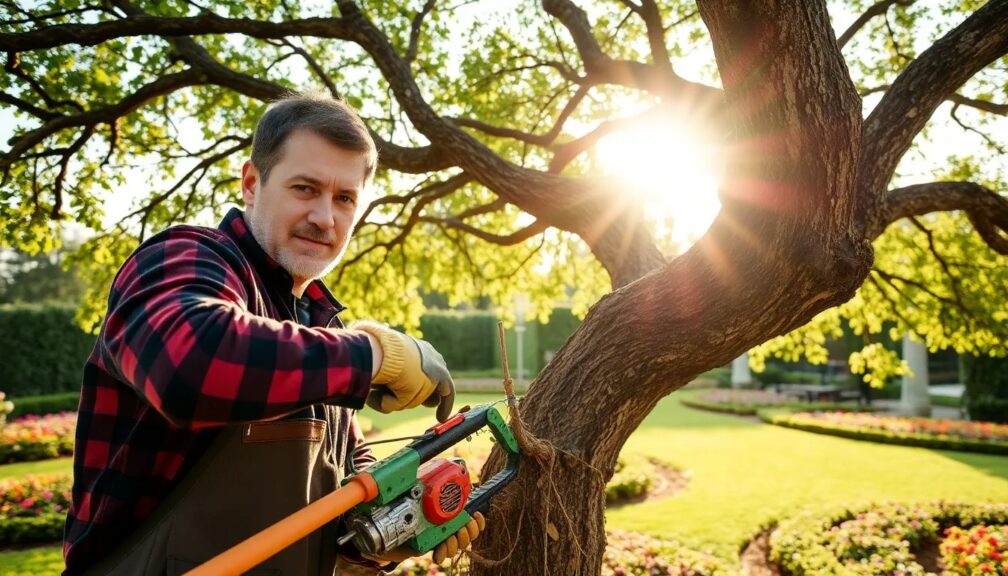Can you remove tree roots without removing the tree

Understanding the Possibilities of Tree Root Removal Without Harming the Tree
When it comes to landscaping dilemmas, homeowners often ponder whether it's feasible to tackle problematic tree roots without necessitating the removal of the entire tree. This question arises when roots surface above ground, leading to issues such as cracked sidewalks, damaged foundations, or disrupted plumbing systems. In this insightful article, we explore the delicate balance between preserving a tree's health and mitigating the risks posed by invasive roots. We'll discuss various strategies, including root pruning and barrier installation, to manage root growth effectively while keeping the tree intact. Join us as we delve into the methods that can help protect your property's structural integrity and maintain the natural beauty of your landscape.
Can I remove tree roots without killing the tree?
Embarking on the delicate task of tree root removal, many homeowners are met with the critical question: can you navigate this tricky process without causing fatal damage to your beloved tree? The truth is, root removal is not just a shovel-and-pickaxe job; it’s a fine art that requires knowledge, precision, and care.
Removing roots can be likened to performing surgery. Every cut must be considered and precise. The process involves understanding which roots are safe to remove and which are vital for the tree's survival. Not all roots are created equal, and therein lies the crux of the matter.
Roots serve as the life support system for a tree, providing essential nutrients and stabilization. But what if they are causing damage to your property, or what if they've become a safety hazard? The fear of making the wrong move and damaging your tree can create a real sense of urgency and concern.
Imagine discovering the secrets to safely pruning roots, allowing you to manage your landscape while keeping your trees healthy. Envision the satisfaction of resolving conflicts between roots and your property's infrastructure, without the remorse of losing a tree.
The key points to consider when attempting such a task include:
- Identifying critical roots: those that are important for the tree's stability and health.
- Understanding the proper techniques for a clean and safe cut.
- Timing the root removal to minimize stress on the tree.
As you delve deeper into the subject, you'll find that knowledge is power. The more you know about the intricate balance between a tree's root system and its overall health, the better equipped you'll be to make the right decisions. So, how can you equip yourself with the necessary strategies and techniques to ensure the longevity of your tree? Stay tuned as we explore the fascinating world of root management, where every decision can mean the difference between a thriving tree and a withered stump.
Is it okay to leave tree roots exposed?
The sight of exposed tree roots can evoke a sense of natural beauty and rawness in a landscape. Yet, beneath this aesthetically pleasing surface lies a question that holds the key to the health and longevity of your cherished trees.
Imagine walking through your garden and seeing a network of roots sprawling across the soil like a living piece of art. It's a common scene, but have you ever stopped to consider the potential impact on the tree's well-being?
The truth is, the exposure of tree roots is a double-edged sword. On one hand, it can lead to a majestic and rugged look that might make your garden the envy of the neighborhood. On the other, the hidden dangers could compromise the stability and growth of your green giants.
Firstly, an exposed root system may become vulnerable to physical damage. Lawnmowers and foot traffic aren't just inconveniences; they're potential threats that can scar the roots, leaving trees susceptible to disease and decay.
Secondly, without the insulation provided by soil, roots are at the mercy of the elements. Extreme temperatures and inadequate moisture levels can spell disaster. The delicate balance of nature's blanket is not something to be cast aside without thought.
But before you rush out with shovels and mulch, take heed. The solution is not as simple as covering them up. The depth at which you re-soil, the materials used, and the specific species of tree all play critical roles in the outcome.
Many gardeners act with haste, only to find their efforts have backfired. Overzealous covering can lead to root rot, oxygen deprivation, and a host of other issues that could send your leafy companions to an early grave.
So, what's the verdict? To uncover the answer, one must delve into the fascinating world of arboriculture, where every decision can be the difference between a thriving ecosystem and a botanical catastrophe.
Stay tuned and ready to become the custodian of your garden's future. The fate of your trees hangs in the balance, and the next steps you take could change everything. Are you prepared to discover the secrets of proper tree root care? The journey begins now.
Will roots continue to grow after a tree is removed?
Imagine walking through your garden after recently having an old tree removed. The stump is gone, but is the story really over? What if beneath the surface, a network of living roots is still sprawled out, teeming with life and ready to spring forth anew?
Sounds intriguing, right? Well, it's not mere fantasy. The survival mechanisms of trees are a marvel of nature, and they don't simply give up when the main trunk is cut down. Certain species are particularly adept at clinging to life, sending up shoots and attempting to reclaim their place in the sun.
But here's the catch: whether or not roots will continue to grow depends on several factors—tree species, root health before removal, and the environment they're in. For example, trees like poplars, willows, and elms are notorious for their tenacity. They have an uncanny ability to produce sprouts from roots even after the tree seems gone.
Have you ever heard of the term root suckering? It's a phenomenon that could transform your understanding of a tree's lifecycle. Those persistent roots can give rise to new trees, a process that can be a blessing or a curse depending on how you view it.
Are you thinking about the trees in your own backyard now? Curious about the potential growth lurking beneath the soil? The answers might surprise you and change the way you manage your green space.
Stay tuned, as we delve deeper into the world of post-removal root activity. You'll discover which trees you might need to keep an eye on and learn how to handle the unwelcome surprise of new growth. This is a tale of resilience and the unstoppable force of nature that could be unfolding right under your feet. Don't miss the astonishing revelations about to take root in the next chapter of your botanical journey.
What is the easiest way to remove tree roots?
Have you ever faced the daunting task of removing tree roots from your garden or backyard? It's a challenge that can turn into a weekend of sweat and toil. But imagine finding a way to tackle this job with ease, transforming your landscape without the usual back-breaking effort. Intrigued?
The secret to effortless root removal lies in understanding the nature of the roots you're dealing with. Shallow, smaller roots can often be manually pulled out with basic tools like a shovel or root saw. However, for those more stubborn, deeply entrenched roots, you'll need to up your game.
One effective method is using a stump grinder, which allows for quick and thorough removal. While it may sound intimidating, stump grinders can be rented and operated with minimal instruction. Not only does this save time, but it also saves you from the potential strain of manual removal.
For the DIY enthusiast, there's the option of chemical stump removers. These products accelerate the decomposition process, making the roots easier to break apart and remove over time. The anticipation of finally clearing that pesky stump can be exhilarating – think of the pristine, root-free soil that awaits!
It's this blend of anticipation and relief that will have you on the edge of your seat, ready to reclaim your garden from the clutches of old tree roots. The transformation of your outdoor space is closer than you think, and the path to achieving it is now clearer than ever.
Ready to learn more and start your journey to a root-free garden? Keep reading, as we unveil the tools, tips, and tricks that will help you master the art of root removal. Say goodbye to the days of relentless digging and hello to a streamlined, effective approach that will leave onlookers in awe of your gardening prowess.
Will cutting tree roots kill the tree
Underground Secrets Revealed: The Hidden Life of Tree Roots and Their Mystical Bond with Survival
Dive into the subterranean world of trees and discover a complex, intertwined existence that could change your perception forever. The act of severing the roots of a tree is akin to cutting off lifelines, creating a ripple of consequences that could lead to its ultimate demise.
Root Functions: More Than Meets the Eye
1. Water and Nutrient Absorption: Trees rely on a vast network of roots for the essential uptake of water and nutrients. What happens when these channels are compromised?
2. Structural Support: Roots anchor a tree, providing stability against forces of nature. Imagine the risk when this foundation is weakened.
3. Storage: Roots are the hidden pantries and warehouses, storing vital reserves. Could trimming them rob a tree of its much-needed energy bank?
The Dynamic Response of Trees: A Surprising Twist
Trees aren't passive victims; they respond dynamically to root interference. The question is, how does this resilience play out, and is it always enough to save the tree?
Life after Loss: The Regenerative Power of Trees
Remarkably, trees can sometimes recover from root damage, initiating a process of healing and regrowth. But don't be fooled—there are limits to this regenerative power. What tips the balance between recovery and fatality?
The Art and Science of Root Management: A Path of Coexistence
Learn about the delicate procedures used by arborists to ensure that both trees and human infrastructure can coexist. How do they decide which roots to cut and which to preserve?
Stay Tuned for a Deep Dive
Unlock the secrets of root care and the surprising outcomes of tree resilience by continuing to read. Engage with the intricate dance between human activity and the natural survival of our leafy companions. What will it take to maintain this balance? Discover more about the fascinating world beneath our feet and the silent whispers of the trees that beg for understanding and careful consideration.
Consejo final: Ensure to consult with an arborist to assess the health of the tree and the necessity of root removal. If root removal is deemed necessary, proceed with care to avoid significant damage to the tree's stability and health. Wishing you success with your tree care endeavors. May your garden thrive!
 What is the best tool to remove small saplings
What is the best tool to remove small saplings What is the best tool to cut small roots in the ground
What is the best tool to cut small roots in the ground What are the traditional tools used for harvesting
What are the traditional tools used for harvesting What is the best tool to harvest vegetables
What is the best tool to harvest vegetables What is a modern tool used for harvesting
What is a modern tool used for harvestingIf you want to know more about similar articles like Can you remove tree roots without removing the tree you can visit category Gardening Tools.